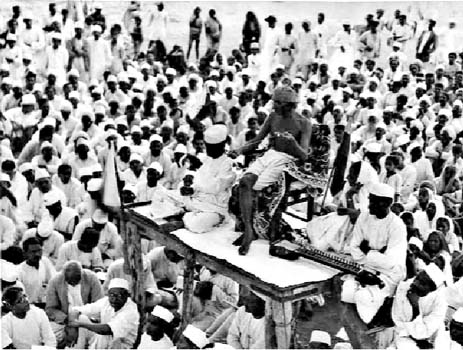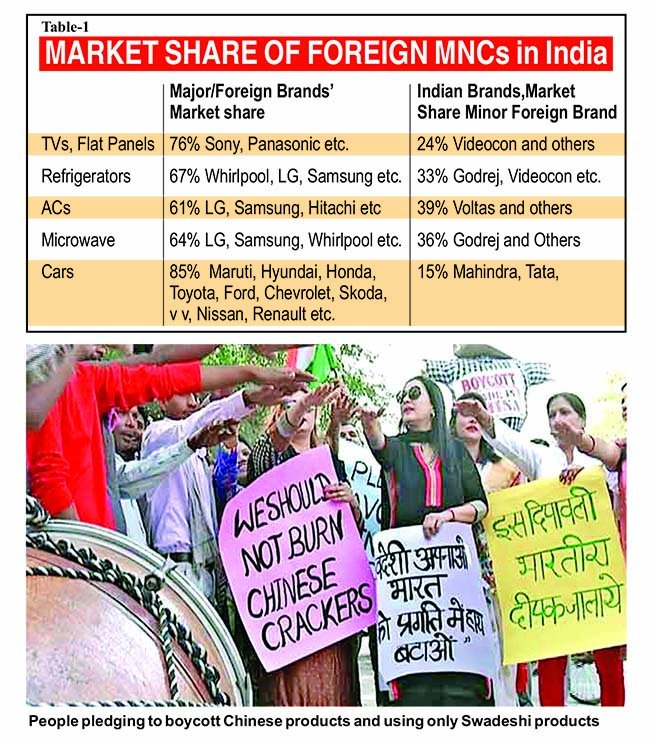
Gandhiji and other leaders during the Swadeshi Movement
True Swaraj presupposes Swadeshi to ensure hold on major share of ‘Made by India’ products into all categories to facilitate indigenous ownership and of control over the industry, trade, commerce, services and agriculture, including the food system
Whenever someone refers to ‘Swadeshi’ a logical corollary emerges that Bharat is a sovereign nation, where we elect our own governments at the Centre and states, then what is alien or ‘Videshi’. On having a glance at the ownership and control of our industry, commerce, services and agriculture, including the food system, we find overwhelming foreign ownerships and control with near-monopoly or with more than two-thirds or half the market share with foreign brands of foreign multinational corporations (MNCs). Almost the cent per cent share in the soft drinks; two thirds in the consumer durables, including the white goods, up to three-fourths in the FMCG, health care and hygiene-related products and toiletries; more than 85 per cent of four-wheelers; 50 per cent plus in scooters and so on, is controlled by the foreign MNCs. To the contrary, till mid-nineties, around 80 per cent or more of the market share, even up to cent per cent as well of several products was held by the indigenous brands, whose components were also domestically produced, leading to manifold employment generation and economic value addition in the downstream value chain. Today, most of the product lines in the markets are dominated by the foreign brands, either imported, or merely assembled i.e. made out of imported components, whereby most of the value additions, up to 80-90 per cent of the value in the total sale value is added outside the country. Especially the technology-intensive value additions are located outside the country, depriving the country of any high tech value additions and the underlying sunrise technologies. It poses a sensitive and serious question, who should or would own the means of production of the country, including the service organisations as well as our trade? Equally formidable question is who should own the means of employment, media and technology.
The overwhelming and ever-growing hold of foreign multinational companies (MNCs) over our manufacturing and service sectors, where the growing hold of the foreign brands has been reducing our country to centre of mere assembly lines of foreign MNCs, wherein most of the technology-intensive activities, which are key to the original equipment manufacturing as well as for employment generation and economic value addition, in the downstream value chain of manufacturing process, are being shifted out of the country by the foreign multinational companies (MNCs) holding the major market share. For instance in mobile handsets 4-6% valve addition in the form of assembling is being done by the Chinese companies.
Liberal imports with enhanced FDI have kept on jeopardising the growth of the domestically owned industry, trade, commerce and infrastructure ever since the liberalisation of imports and promoting of foreign investments. Growing imports have caused vast closures of domestic enterprises, and the promotion of FDI has led to rapid increase in foreign ownership and control of trade, commerce, industry, services, infrastructure, agriculture and even of the civic infrastructure, including the real estate, highways, and so on in the country. Table-1 shows, how the foreign brands have engulfed domestic and made by Bharat products and brands.
Likewise, the liberal imports into the country, including those from China have raised the deficit in foreign trade to 90 fold in 28 years (vide Table-2). Excess of FDI than our ability to sustain profit repatriation by the foreign MNCs has fuelled investment-income deficit to around $40 billion per annum. Consequently, the rupee-dollar exchange rate has deteriorated from Rs 18 to 69 per dollar in these 28 years of liberalisation. India also appears to have been trapped in a vicious cycle of over-dependence on foreign capital inflows for bridging the consistent and ever-growing high deficits in trade and current accounts, besides a growing deficit in investment income as well. The successive governments over the years, since the onset of economic reforms in 1991 had to keep on opening ever more sectors for foreign direct investments and also had to continuously relax foreign portfolio investment norms merely to bridge the deficits in trade and current accounts as well as from investment income outflows. All out efforts to promote foreign investments (direct and portfolio investments without matching outbound direct investments (ODI) has led to heavy adverse balance in investment incomes, besides causing passage of ownership and control of industry, trade and commerce to the foreign Multinational Corporations (MNCs).

Import surge in all these years of liberalisation, on account of liberalised imports, have also led to widespread industrial closures and overwhelming hold of foreign MNCs in manufacturing sector. The MNCs, in turn, shift the technology-intensive value additions out of the country leading to poor economic value addition in price we pay for each product of foreign MNCs. Today, we have less than 3% contribution in world manufacturing, in spite of 17.8% share in world population due to extreme lack of ‘Made by India’ goods. Whereas, China has 22.5% share in world manufacturing. It has helped China to raise the percentage of middle-income group in the total population, the highest in the world by virtue of centralisation of technology-intensive and high-value addition activities in downstream value chain in manufacturing. China too had only 2.4% share in world manufacturing in 1981. It has, thereafter, pushed even the US too to second position with 17.2% share in world manufacturing. India has even been experiencing deindustrialisation in several sectors, on account of liberal imports and growing foreign direct investments (FDI) as most of the foreign MNCs, which have brought FDI into India have begun to outsource their components or completely knocked down (CKD) kits, all from outside and are merely assembling their products in the country. So, the real manufacturing, including manufacturing of the original equipment in the downstream value chain has been going down. Besides, the Indian brands and indigenously manufactured products are also fast losing their market share, and many of these are vanishing. They are being replaced fast by the Chinese or other foreign brands. Even many of the Indian brands too have Chinese or other imported components or even sometimes the Indian brands are also assembled outside India, mostly in China, and merely bear the tags of Indian brands. Therefore, there is an urgent need for pursuing the strategy to promote ‘Made by India’ products and brands. The foreign MNCs too in the name of making in India are often assembling their products out of imported components to give an eyewash of manufacturing in India. In several sectors India has only a minuscule share in manufacturing. For example, in world ship-building, share of India is just 1%. While South Korea, which has 5% of our area and 5% population has 26% share in world ship-building, in spite of the fact that India is 4th largest steel producer in the world with a large pool of skilled manpower. Singapore has 7.5 times the high technology exports than India while India 5250 times larger than Singapore in area. Almost every year 1.2 crore youth have been coming in the age of employment. So, India needs to add 1.2 crore jobs, which is possible by enhancing manufacturing of Made by India or Made by Bharat products and brands.
Strategy for SWADESHI
To turnaround this situation of persistent rise in trade and current account deficits as well as in the deficit in investment income, and also to remedy our growing dependence over foreign investments for bridging the current account deficits along with saving various sectors of the economy, including the trade, commerce, industry, infrastructure, services and agriculture, from further slipping into foreign ownerships, India should chart a course of self-reliance and Swadeshi inter alia by developing ‘Made by India’ products and brands through endeavours like promoting and adopting techno-nationalism and economic patriotism. Developing homegrown technologies and promoting these, through mandatory norms and other methods is the key to enhance techno-nationalism. It can alone help the country to launch ‘Made by Bharat’ products and brands to alleviate from the country’s growing dependence upon imports, FDI and helplessly, watching outflow of money leading to job losses, depreciation of rupee and loss our hold over the industry, commerce and trade, of the country. Economic patriotism inter alia reflects one’s resolve to buy the Made by India goods, wherever available. Which can be said pursuing ‘Swadeshi’.
Patronising Swadeshi or Made by Bharat products and brands would facilitate domestic manufacturing creation of jobs inclusive growth with indigenous ownerships in trades, commerce and industry. On account of the strong sense of Swadeshi, only 4% foreign cars are sold in Japan. To the contrary in India only 15 cars being sold are made by India, rests are foreign-owned brands. Out of this economic patriotism Japan has 10% share in world manufacturing in spite of mere 1.6% share in world population. China too has 22.5% share in world manufacturing. Whereas India has less than 3% share in world manufacturing in spite of 17.8% share in world population. In this 3% as well more than 50% in foreign-owned and mostly based on imported original equipments. Hence true Swaraj presupposes Swadeshi to ensure hold on major share of “Made by India” products into all categories to facilitate indigenous ownership and of control over the industry, trade, commerce, services and agriculture, including the food system.
(The writer is Vice Chancellor of Gautam Buddha University, Greater Noida)













Comments